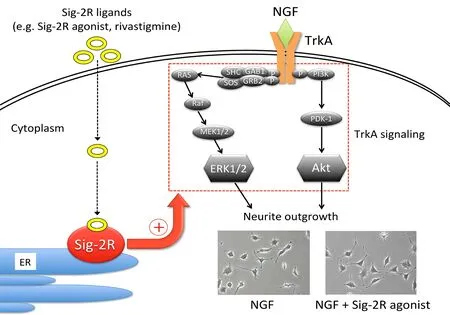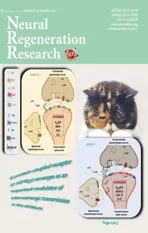Sigma-2 receptor as a potential therapeutic target for treating central nervous system disorders
2019-07-18KazukiTerada,KeisukeMigita,YukariMatsushima等
The sigma receptor (Sig-R) was first reported by Martin et al. (1976) and was initially classified into the opioid receptor family. However, Sig-R was subsequently found to differ from the opioid receptor in various studies including ligand binding assays and autoradiography analysis (Tam and Cook, 1984).Sig-R is widely distributed in tissues such as central nervous,digestive, immune, and endocrine tissues. There are two types of Sig-R: sigma-1 (Sig-1R) and sigma-2 receptors (Sig-2R). Recent studies reported that each subtype has distinct cellular and physiological functions. Since Hanner et al. (1996) successfully cloned the Sig-1R gene, the functions of Sig-1R have been widely evaluated in the fields of cell biology, molecular biology, cancer, immunology, and behavioral neuroscience. Particularly, it has been suggested that Sig-1R activates neurons in the central nervous system (CNS) and contributes to physiological functions such as memory and cranial nerve protection. In contrast,Sig-2R has not been cloned. Sig-2R is thought to be involved in cellular processes related to neuropathy, as pharmacological studies suggested that Sig-2R is widely distributed in the CNS.Recently, Alon et al. (2017) identified the gene encoding Sig-2R.This perspective focuses on whether Sig-2R is useful as a therapeutic target for CNS disorders such as Alzheimer's disease,Parkinson's disease, and depression, based on the structure of Sig-2R and its role in nerve growth.
Structure of Sig-2R:Sig-2R is a membrane protein of 18-21 kDa and is highly expressed in the liver, kidney, and CNS. Alon et al. (2017) purified Sig-2R from calf liver tissue and found
that it was encoded by TMEM97, a relatively unknown TMEM(transmembrane) gene family in the endoplasmic reticulum.TMEM97 was reported to be involved in cholesterol homeostasis, but the detailed molecular mechanisms remain poorly understood. Structurally, Sig-2R was predicted to be an integral membrane protein with four transmembrane domains containing endoplasmic reticulum retention signals and N- and C-termini that extend into the cytoplasm. Sig-2R requires two acidic groups (Asp29, Asp56) for ligand binding, similar to Sig-1R, which requires Asp126 and Glu172 (Alon et al., 2017). Two aspartic acid residues essential for binding to Sig-2R were predicted to be present near the endoplasmic reticulum lumen side of Sig-2R.
Sig-2R contributes to neuroregeneration:Neurons are interconnected by neurites including axons and dendrites to form complex neural networks, allowing for communication between neurons to regulate a variety of bodily functions and activities. Neurite outgrowth is a fundamental process for establishing and maintaining nervous system function. Therefore,neurite outgrowth has been measured to evaluate neuromodulatory, neuroprotective, and neuroregenerative effects (Sherman and Bang, 2018). We recently found that compounds with affinity for Sig-2R enhance nerve growth factor (NGF)-induced neurite outgrowth in PC12 cells (Terada et al., 2018). The Sig-2R agonist PB28 enhanced NGF-induced neurite outgrowth,and this enhancement was completely blocked by the Sig-2R antagonist SM-21. Furthermore, we found that rivastigmine,a therapeutic agent for Alzheimer's disease, activated Sig-2R and enhanced activation of the NGF receptor TrkA signaling pathway. Rivastigmine significantly enhanced NGF-induced neurite outgrowth; this enhancement was also inhibited by SM-21. In addition, rivastigmine upregulated the phosphorylation of Akt and ERK1/2, known to be downstream of the TrkA receptor (Figure 1). However, it is still unclear whether Sig-2R directly activates NGF/TrkA signaling in the absence of NGF. Neurite outgrowth is an important aspect of neuronal maturation, health, plasticity, and regeneration, and damage to neurites causes numerous CNS disorders. Therefore, targeting the function of Sig-2R in neurite outgrowth may be important for treating CNS disorders.

Figure 1 Enhancement of nerve growth factor (NGF)/TrkA signaling by sigma-2 receptors(Sig-2R) in neurite outgrowth.Sig-2R associates with TrkA signaling to activate phosphorylation of TrkA receptor downstream signaling molecules (e.g., Ras/ERK1/2 and PI3K/Akt) in the cytoplasm. In this model, Sig-2R-mediated potentiation of NGF-induced neurite outgrowth occurs by enhancing the phosphorylation of Akt and/or ERK1/2. ER:Endoplasmic reticulum.
Sig-2R-mediated therapeutic approach for CNS disorders:
In the CNS, it is difficult to restore the functions of degenerated neurons or the number of neurons. Therefore, methods for regeneration are necessary to activate surviving nerve cells and form new synapses. Neurotrophic factors such as NGF and brain-derived neurotrophic factor were suggested to prevent the progression of neurodegeneration, as they are responsible for neuronal development, survival maintenance, and injured nerve cell repair in the CNS (Glass et al., 2010). However, the clinical application of neurotrophic factors is very difficult because these macromolecular proteins cannot cross the blood-brain barrier and are easily metabolized in the periphery. An agent that reinforces and enhances neurotrophic factors is expected to be useful as a fundamental therapeutic/prophylactic drug for CNS disorders. Because Sig-2R enhances NGF action, it is considered as a promising target for treating CNS disorders (Terada et al., 2018). Additionally, a Sig-2R agonist showed neuroprotective effects and preserved cognitive function (Yi et al., 2017).Clinically, rivastigmine shows activity towards Sig-2R to ameliorate depression symptoms and psychoneurotic symptoms;these results have not been observed with other Alzheimer's disease therapeutic drugs (Bullock et al., 2005). On the other hand,a phase 1 clinical trial of Sig-2R allosteric antagonist Elayta(CT1812), which prevents and displaces the binding of amyloid β oligomers with neurons, was performed, to evaluate its potential as a novel therapeutic candidate for Alzheimer's disease(Grundman et al., 2019). These reports demonstrate that Sig-2R is a potential target for treating CNS disorders.
Conclusion and future perspectives:Sig-2R plays an important role in neuron regeneration and growth, but its function is not completely understood, and further studies are necessary. The enhancing effect of Sig-2R on NGF-induced neurite outgrowth has revealed new aspects of Sig-2R function in neurological studies. In the CNS, neurite outgrowth is an important step in neuronal regeneration. Therefore, determining the regulatory mechanism of neurite outgrowth involving Sig-2R may lead to a paradigm shift in the treatment of CNS disorders.
This work was supported by Japan Society for the Promotion of Science KAKENHI (JP16K18888, to KT).
Kazuki Terada*, Keisuke Migita, Yukari Matsushima,Chiaki KameiLaboratory of Drug Design and Drug Delivery, Faculty of Pharmaceutical Sciences, Fukuoka University, Fukuoka, Japan(Terada K)Department of Drug Informatics, Faculty of Pharmaceutical Sciences, Fukuoka University, Fukuoka, Japan (Migita K)Department of Pharmacology, Faculty of Pharmaceutical Sciences, Yasuda Women's University, Hiroshima, Japan(Matsushima Y, Kamei C)
*Correspondence to: Kazuki Terada, PhD, kterada@fukuoka-u.ac.jp.orcid: 0000-0003-0257-5812 (Kazuki Terada)
Received: February 16, 2019
Accepted: April 17, 2019
doi: 10.4103/1673-5374.259609
Copyright license agreement: The Copyright License Agreement has been signed by all authors before publication.
Plagiarism check:Checked twice by iThenticate.
Peer review: Externally peer reviewed.
Open access statement:This is an open access journal, and articles are distributed under the terms of the Creative Commons Attribution-NonCommercial-ShareAlike 4.0 License, which allows others to remix, tweak, and build upon the work non-commercially, as long as appropriate credit is given and the new creations are licensed under the identical terms.
杂志排行
中国神经再生研究(英文版)的其它文章
- Etomidate affects the anti-oxidant pathway to protect retinal ganglion cells after optic nerve transection
- Normal tension glaucoma: from the brain to the eye or the inverse?
- Mesenchymal stromal cell therapy for damaged retinal ganglion cells, is gold all that glitters?
- MicroRNAs as biomarkers of diabetic retinopathy and disease progression
- Diabetic neuropathy research: from mouse models to targets for treatment
- Potential therapeutic roles of retinoids for prevention of neuroinflammation and neurodegeneration in Alzheimer's disease
